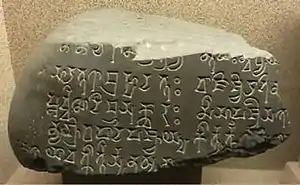
The Nagajari-Khanikargaon rock inscription is a 5th-century land grant discovered in the Nagajari area of the Golaghat district.[1] The artifact is fragmentary, with inscriptions in Sanskrit written in the eastern variety of the Brahmi script.[2] In style, language, and script, the inscription is very similar to the Umachal and Barganga rock inscriptions. Additionally, since it betrays no influence of a local Prakrit, this inscription is often placed earlier than the Umachal rock inscription. It also indicates that Indo-Aryan culture had spread to the Golaghat region by the 5th century.[3] It is also speculated that it might belong to a different dynasty unrelated to the Varmans of Kamarupa.[4]
Text
The text is fragmentary, with no complete sentence available, though it is believed it was written in the sloka meter.[5] Since the text is fragmentary, no English translation is available. Nevertheless, it is ascertained that the inscription is related to a grant of land, with the area bounded by "Dibrumukkhada" (a water body) in the east and a Banyan tree in the west.
Discovery
The rock inscription was collected by Luduram Saikia of Khanikargaon among some ruins in the Nagajari area prior to 1972. Around 1972, this stone fragment was noticed by M K Saikia at Saikia's residence, when it was reported.[6]
Notes
- ↑ (Sharma 1978, pp. 303–305)
- ↑ (Sharma 1978, p. 303)
- ↑ (Sharma 1978, p. 305)
- ↑ (Shin 2018, p. 29): Some stone inscriptions assigned to the fourth and fifth centuries refer to the four names of kings who have possibly ruled over this area. The date of the Nagajari-Khanikargaon fragmentary stone inscription is considered to be earlier than that of the Umachal inscription of the Varmans. It is nevertheless too early to make any definite conclusion as the archaeological and inscriptional evidences are still limited to date. Furthermore,the absence of large-scale archaeological excavations in the region prevents us from tracing a detailed picture of society in the earlier period.
- ↑ (Sharma 1978, p. 304)
- ↑ (Sharma 1978, p. 303)
References
- Sharma, Mukunda Madhava (1978). Inscriptions of Ancient Assam. Guwahati, Assam: Gauhati University.
- Shin, Jae-Eun (2018), "Region Formed and Imagined: Reconsidering temporal, spatial and social context of Kamarupa", in Dzüvichü, Lipokmar; Baruah, Manjeet (eds.), Modern Practices in North East India: History, Culture, Representation, London & New York: Routledge, pp. 23–55